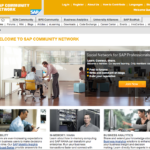Most brands dream of having a vital user community that creates on-going dialog between the brand and its customers. But few have succeeded on the level of the SAP Community Network which is led by Chip Rodgers. I interviewed Chip for an upcoming case study on FastCompany.com and in advance of his presentation at the B2B Corporate Social Media Summit September 28/29 in Philadelphia. The following is my Q&A with Chip. Admittedly, it is long one but well worth studying if you are thinking about creating your own community.
 DN: Can you give some background on the SAP Community Network?
DN: Can you give some background on the SAP Community Network?
The SAP Community Network actually started about eight years ago, and so we’ve had a little bit of time to ramp up. We currently have about 2.5 million members, and it’s a very active community. We get between a million and a million and a half unique visitors a month and about 3,000 to 4,000 posts a day in discussions and blogs and wiki pages.
DN: Tell me about the membership of the SAP Community Network.
It’s about 50% customers and then another probably 30% partners and then we have a large group of employee members as well. There are also independent contractors, developers— just people who are interested in the SAP ecosystem. It’s open to anyone that wants to join. There are a few core pieces of information that we ask for and obviously unique email address.
DN: From a content standpoint, with all these members, are you constantly feeding this beast yourself or is it somewhat self-sustaining?
I have two teams. The content team works with about 400 SAP experts to feed the community with a lot of our formal content: white papers, articles, solution briefs, eLearning, videos, etc. I have a team of about 12 working with a group of stakeholders that are SAP solution managers or folks from support or people in solution marketing that have all the actual information, the expertise and are actually the ones that are building the content. I’ve also got a group of six that are managing the community-generated content, so that’s our blogs and forums and wikis, and similarly they’re working with a group of about 700 moderators that are in the community.
DN: You know the scale of this community is kind of mind-boggling. Can you draw a direct line between your activities and your ROI?
More and more we’re able to show that there is a connection. We’ve gotten to the point where we’re running a lot of webinars on different topic areas, different product areas. We’ve really cut back with list-buying and some of those traditional marketing costs to get people to come in and listen to a webinar, learn about a new product area, and then take the next step as a pipeline opportunity.
Drew: You started this in 2003, which predates Twitter and Facebook, and I’m curious how you brought [them] into your community. Are they adjuncts or are they truly integrated into this?
Having this background of engaging with the community, when Facebook and Twitter came along, they were natural extensions and ways of engaging with the community. We now have a group that is really focused just purely on social media. We work together to leverage the community and our social media activity. A little bit more specifically, we do a number of things like, if you post a blog in the community, we have an RSS feed to a Twitter account so it automatically tweets the title of the new blog that was published. We think of Twitter, Facebook, LinkedIn, even YouTube, as kind of extensions— concentric circles around the community— to reach community members and try to get the word out.
DN: Was it tough in the beginning to get management behind the community?
We laid a lot of groundwork for social media within SAP. We were fortunate that we had a board member that thought it was the thing to do and defended it every time. When we first opened the communities with blogs and forums and wiki, some executives were nervous – saying, “why should we create a place just for people to complain?” But our feeling was that there are plenty of public places for people to criticize the company, why not create the place where we can be a part of the conversation? And fortunately, our board defended it.
DN: Has the community ever defended the brand?
What we’ve found is if you work with the community and build trust, and you’re open about how you engage and you answer questions and address issues that come up, the community will support you. It’s not always SAP that has to defend [itself] when someone goes haywire. We see this all the time where somebody says something negative or even a little wacky in the community, and your knee-jerk reaction might be, we have to answer that. And what ends up happening is a lot of other community members come in and say, “Well you might have a point here, but this is way over the line.” The whole group kind of comes together.
DN: What are the other ways that you report on the success, or what are the metrics that you guys look at to rationalize your existence?
We actually have a few metrics. One is just purely in terms of activity and contributions in the community, page views, member satisfaction, things like that. We do those transactional kinds of things with the community to makes sure that we’ve got good content that people find interesting, so that’s one level of measurement. One of our KPI’s is driving activity to those webinars that turns into real pipeline opportunity dollars. It’s traceable back to activity in the community.
The third is a part of the community called SAP EcoHub (http://ecohub.sap.com). It started as an online store for our partners to set up storefronts and sell their products. We’ve expanded it to include SAP products as well. It is connected to the community so that if there are conversations going on about certain product areas, we have links in those conversations going back to EcoHub. If you happen to be on a conversation you can see the product. That is an increasing channel for us, for our partners and for SAP to drive revenue directly.
DN: You have a few people that are in the conversation, how do you make sure that they are all on brand?
We do have a social media corporate policy, guidelines, best practices case stories, and training courses. We have an active internal social community, so there’s a lot of discussion and activity and assets [and] resources available to people when they start to put a toe in the water in social media. A lot of those principles are similar to when anybody goes for media training, for example. There are a few guiding principles like, “Don’t talk about things that you don’t know about.” And stay away from forward-looking statements like, “We’re going to do this,” or “We’re going to do that.” But otherwise I think a lot of it is just common sense.
DN: You have this substantive, meaty community where people are actually participating, and you’ve already proven its worth and along comes Twitter and Facebook. Has there been conflict because [social media] is a separate group, and it’s not part of your group?
There is a social media group driving policies, best practices, training, reporting, and other aspects of social media for SAP, but we’re all part of marketing. It’s interesting because community and social media are somewhere in the middle of several traditional corporate groups. It’s a little bit of marketing; it’s a little bit of communications; it’s a little bit of support, there’s an aspect of listening for product roll-in, and there’s an aspect of sales channel. So there are always discussions about where does it really belong. But community and social media are about people connecting – so if you’re doing it right, the entire organization is responsible for connecting with customers and partners in their respective areas. So yes, we are separate groups, but we have a communities and social media council of leaders from each of those groups as well as social media ambassadors embedded throughout organizations and geographies at SAP.
DN: With 2.5 million community members, your activities are dwarfing anything SAP might have on Facebook [or] Twitter. How as the marketing/social team dealt with this?
We actually work very well together and leverage each other’s strengths on a nearly daily basis. But it’s interesting that when we were first having discussions about Communities joining marketing, our CMO was saying “There’s an opportunity to learn from what Community Network has done. We need to have more conversations and engage with our audience. We can’t just create another email blast with a bunch of creative and offers.” It’s been a cultural change within the company.
DN: Have your content development efforts had a measurable impact on SEO?
We are very much SEO champions, and it’s been through experience. We had to figure out what to do on all those pages to do better with search engine: where things are laid out; how are we tagging pages; what are the titles in the pages, how are URLs formed. So many things factor into it. We had this three-month project just to go through everything and then get the word out to all the stakeholders and get everybody to update all their pages. I mean it was dramatic; We were bumping along at around 400,000 unique monthly visitors, and all of a sudden we shot up to like 900,000. It was unbelievable— just blew me away.




